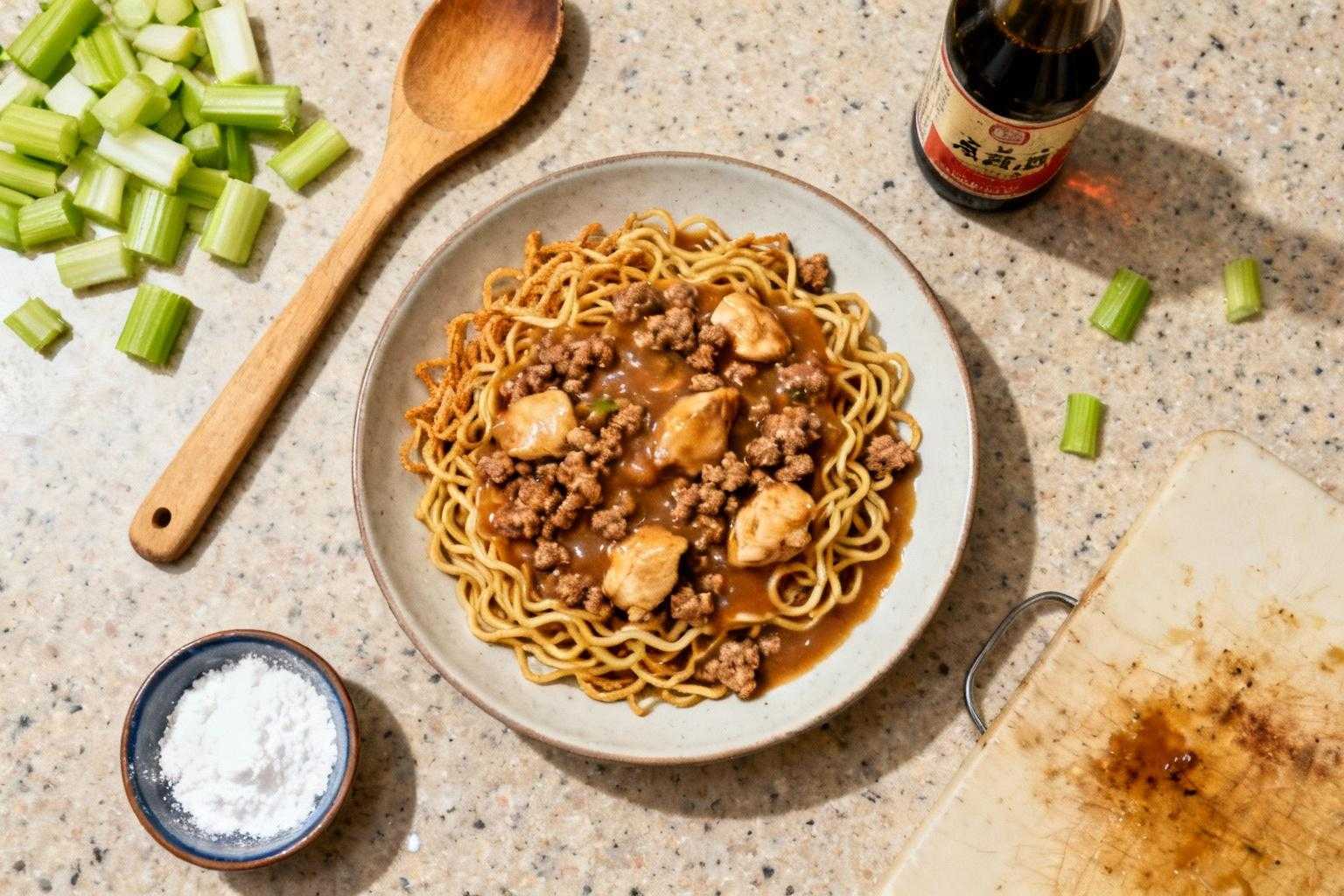The aroma of sizzling ground pork and chicken transports me back to my grandfather’s kitchen, where he’d spend hours perfecting his version of Minnesota Chow Mein. This uniquely American interpretation of Chinese cuisine originated at the legendary Nankin Cafe in Minneapolis, becoming a Midwestern comfort food staple for generations. What makes this dish so special is the beautiful contrast between the crispy chow mein noodles and the rich, savory gravy-like sauce that cascades over them. It’s humble food that somehow manages to feel both nostalgic and deeply satisfying.
The Story Behind Minnesota Chow Mein 📖
American-style chow mein differs dramatically from its Chinese counterpart. Where traditional Chinese versions typically stir-fry noodles with ingredients, this Midwestern adaptation creates a hearty, savory topping served over crispy dried noodles. The Nankin Cafe in Minneapolis popularized this style from 1919 until 1999, creating a regional specialty that locals still crave today.
During my culinary training, I worked with a chef whose father had been a line cook at the Nankin. He insisted that the secret was in the ground meat mixture and the perfect sauce consistency – neither too thick nor too thin. After tasting his family recipe, I understood why customers would line up around the block for this humble yet irresistible dish.
Essential Ingredients 🧾
- 1 lb (454g) ground meat (½ lb pork and ½ lb dark meat chicken)
- 2 cups (200g) celery, chopped into ½-inch pieces
- 4 cups (950ml) chicken stock (homemade if possible)
- 2 tsp (10ml) dark soy sauce
- ¾ tbsp (11g) salt
- ¾ tbsp (9g) sugar
- ¼ tsp (1.25ml) sesame oil
- ⅛ tsp white pepper
- 5-6 tbsp (40-48g) cornstarch, mixed with cold water to form a slurry
- Crispy chow mein noodles for serving
Chef’s Note: The coarse grind of the meat is crucial for authentic texture. Ask your butcher to coarsely grind the meat, or pulse it yourself in a food processor, being careful not to over-process into a paste. This creates those delightful small chunks that give the dish its signature mouthfeel.
Step-by-Step Instructions 📝
1. Heat a large, heavy-bottomed skillet or wok over medium-high heat. Add the ground pork and chicken, breaking it up with a wooden spoon while cooking until deeply browned, about 8-10 minutes.
2. Add the chopped celery to the browned meat and stir-fry for 2-3 minutes until the celery begins to soften but still maintains its crisp texture.
3. Pour in the chicken stock and bring to a gentle boil. Add the dark soy sauce, salt, sugar, sesame oil, and white pepper.
4. Reduce heat to medium and simmer for 10-12 minutes, allowing the flavors to meld and the celery to reach the perfect tender-crisp consistency.
5. In a small bowl, create a slurry by mixing the cornstarch with ½ cup (120ml) of cold water until smooth.
6. While stirring constantly, slowly drizzle the cornstarch slurry into the simmering mixture. Continue to cook for 2-3 minutes until the sauce thickens to a glossy, gravy-like consistency that coats the back of a spoon.
7. Serve immediately by spooning generously over a bed of crispy chow mein noodles.
Chef’s Secret Techniques 🤫
The key to exceptional Minnesota Chow Mein lies in mastering a few critical techniques. First, brown the meat thoroughly to develop a deep flavor foundation. This initial caramelization creates the rich umami notes that make this dish crave-worthy.
Second, the cornstarch slurry must be added gradually while stirring constantly. I always tell my cooking students to “rain in” the slurry rather than dumping it all at once. This prevents lumps and creates that silky, restaurant-quality finish.
Finally, timing the celery correctly is crucial. It should retain some crispness to contrast with the soft meat and provide textural interest. If you overcook it, you’ll lose that delightful crunch that makes each bite interesting.
Serving & Presentation Tips 🍽️
Traditional Minnesota Chow Mein is best served family-style, allowing everyone to build their own bowl. Start with a generous bed of crispy noodles, then ladle the hot meat mixture over top. The heat from the sauce will slightly soften some noodles while others remain crisp, creating that magical textural contrast.
For a complete meal, I love serving this alongside simple egg rolls (like my Grandma’s Crispy Punjabi Samosas) or steamed dumplings. For dessert, consider a light, sweet finish like my Parisian-Style Nutella Crepes or Triple Chocolate Mousse Cake.
Don’t have access to crispy chow mein noodles? You can substitute with broken rice noodles that have been quickly deep-fried until crisp, or even serve over steamed rice for a different but equally delicious experience.
What I love most about this humble dish is how it represents America’s culinary melting pot—Chinese techniques adapted to Midwestern tastes, creating something entirely new but somehow familiar. Whether you’re seeking comfort food on a cold Minnesota night or want to experience a unique chapter in American culinary history, this dish delivers both satisfaction and a story worth sharing around your table.
